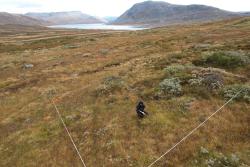Press Release, 02. April 2025
Dark diversity reveals global impoverishment of natural vegetation
Nature study shows that the potential occurrence of plant species is significantly higher
A study recently published in Nature indicates that human activities have a negative effect on the biodiversity of wildlife hundreds of kilometres away. A research collaboration led by the University of Tartu assessed the health of ecosystems worldwide, considering both the number of plant species found and the dark diversity - the missing ecologically suitable species. For the study, over 200 researchers among them one scientist from the Helmholtz Centre for Environmental Research (UFZ) and the German Centre for Integrative Biodiversity Research Halle-Jena-Leipzig (iDiv) studied plants at nearly 5,500 sites in 119 regions worldwide, including all continents.

DarkDivNet site in Norway - one of the research network's 5,500 study areas worldwide.
Photo: DarkDivNet
At each site, they recorded all plant species on 100 m2 and identified the dark diversity – native species that could live there but were absent. About 300 km2 surrounding each site was considered the region affecting the site. This allowed researchers to understand the full potential of plant diversity at each site and measure how much of the potential diversity was actually present.?
The study revealed that in regions with little human impact, such as in the vast forest masses of North America or in Greenland’s tundra, ecosystems typically contain over a third of potentially suitable species, with other species remaining absent mainly due to natural reasons, such as habitats being too far apart or the lack of seed dispersers. By contrast, in forests of western and southern Europe and other regions heavily impacted by human activities, the sites studied contained only one out of five suitable species. Traditional biodiversity measurements, like simply counting the number of recorded species, did not detect this impact because natural variation in biodiversity across regions and ecosystems hid the true extent of human impact. The level of human disturbance in each region was measured using the human footprint index. The index includes factors like human population density, land-use changes (i.e. urban development and conversion of natural to arable land), and infrastructure (roads and railways). The study found that plant diversity at a site is negatively influenced by human impact up to hundreds of kilometres away.
According to the lead author of the study, Professor of Botany of the University of Tartu Meelis Pärtel, the findings indicate that biodiversity can also be reduced in ecosystems that have not been directly modified by humans but are located in areas where human activities have caused habitat fragmentation or have had a dispersed impact on natural areas, for example through pollution. “This result is alarming because it shows that human disturbances have a much wider impact than previously thought, even reaching nature reserves. Pollution, logging, littering, trampling and human-caused fires can trigger local extinctions and prevent recolonisation,” explained Pärtel.
Researchers found that the negative influence of human activity was less pronounced when at least 30% of the surrounding region remained relatively pristine. According to Pärtel, this supports the global nature conservation targets to protect about one third of the land. The study highlights the importance of maintaining and improving ecosystem health beyond nature reserves. The concept of dark diversity provides a practical tool for conservationists to identify absent suitable species and track progress in restoring ecosystems. The study was conducted thanks to the international research network DarkDivNet, which started in 2018. The network is led by the University of Tartu, and its partners include researchers from nearly two hundred research institutions in 37 countries.
For the study, Lotte Korell and Dr Kristin Ludewig from the University of Hamburg recorded all the plant species at 31 sites in the Lüneburg Heath - mainly composed of mixed birch-oak forest. This type of forest is considered as semi-natural vegetation, as the soil conditions are very sandy and nutrient-poor. Grasslands and heathlands were also sampled occasionally. ‘In our study area, both the Human Footprint Index with close to 15 and the dark diversity with around 40 plant species can be considered relatively high compared with other regions’ says Lotte Korell. Although the Lüneburg Heath contains a large proportion of semi-natural areas, these values reflect the extent to which the landscape and biodiversity are influenced by humans.
Publication:
Pärtel, M., R. Tamme, C. P. Carmona, K. Riibak, M. Moora, L. Korell … , and M. Zobel (2025). "Global impoverishment of natural vegetation revealed by dark diversity." Nature. https://www.nature.com/articles/s41586-025-08814-5
Further information
Dr Lotte Korell
Department Species Interaction Ecology at UFZ and iDiv
lotte.korell@ufz.de
UFZ press office
Susanne Hufe
Phone: +49 341 6025-1630
presse@ufz.de
In the Helmholtz Centre for Environmental Research (UFZ), scientists conduct research into the causes and consequences of far-reaching environmental changes. Their areas of study cover water resources, ecosystems of the future, environmental technologies and biotechnologies, the effects of chemicals in the environment, modelling and social-scientific issues. The UFZ employs more than 1,100 staff at its sites in Leipzig, Halle and Magdeburg. It is funded by the Federal Government, Saxony and Saxony-Anhalt.
www.ufz.deThe Helmholtz Association contributes to solving major challenges facing society, science and the economy with top scientific achievements in six research fields: Energy; Earth and Environment; Health; Key Technologies; Matter; and Aeronautics, Space and Transport. With some 39,000 employees in 19 research centres, the Helmholtz Association is Germany’s largest scientific organisation.
www.helmholtz.de